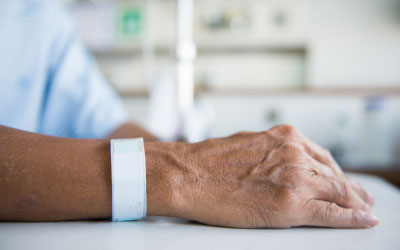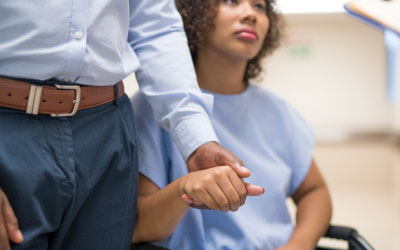Chemotherapy for leukemia
Chemotherapy, more commonly known as chemo, is the first line of treatment for most types of leukemia. As a system-wide type of cancer treatment, the medicine circulates in the bloodstream to damage or kill leukemia cells.
How does chemotherapy treat leukemia?
There are different types of chemotherapy drugs. They all have the same effect: They stop cancer cells from multiplying and growing. Chemo is a highly effective for adults. It’s also an effective childhood leukemia treatment.
Chemotherapy affects leukemia cells in different ways depending on the specific drug. A chemotherapy drug may:
- Change the genetic makeup (DNA) of a cancer cell, altering its ability to reproduce and function
- Damage cancer cells, preventing them from growing and multiplying
- Kill cancer cells
- Stop cancer cells from repairing their own damaged DNA
Who needs chemotherapy for leukemia?
Chemotherapy is typically the first treatment for people who have these types of leukemia:
- Acute lymphoblastic lymphoma (ALL), including B-ALL and T-ALL
- Acute myeloid leukemia (AML)
- Acute promyelocytic leukemia (APL)
- Chronic lymphocytic leukemia (CLL)
- Chronic myelomonocytic leukemia (CMML)
- Hairy cell leukemia
- NPM1-mutated AML
- Large granular lymphocytic (LGL) leukemia
What other types of leukemia does chemotherapy treat?
When appropriate, doctors also use chemotherapy to treat:
- Chronic myeloid leukemia (CML): A targeted therapy drug called tyrosine kinase inhibitors (TKIs) is the primary treatment for CML. TKIs target a rare gene change called the Philadelphia (Ph) chromosome that causes CML. People with CML may get chemotherapy if TKIs stop working or before a stem cell transplant.
- Myelodysplastic syndrome (MDS): Chemotherapy treats high-risk cases of myelodysplastic syndromes that are more likely to develop into AML.
What are the types of chemotherapy for leukemia?
Most people receive more than one chemotherapy drug. Doctors may combine these drugs with other treatments like immunotherapy or targeted therapy. Chemo also takes place before a stem cell transplant.
There are different ways to receive chemotherapy:
- Pills (oral medications)
- Intravenously (IV) into a vein
- Port-a-catheter that consists of a catheter (thin, flexible tube) and port (a device that goes under the skin on the chest and connects the catheter to a vein)
- Intrathecally to treat cancer that spreads to the brain or spine by delivering the drug directly into cerebrospinal fluid via a lumbar puncture (spinal tap) or a device that goes underneath the skin on the scalp
What are the phases of chemotherapy for leukemia?
Chronic leukemias like CLL are slow-growing cancers that may not require immediate treatment. Doctors often recommend a watch-and-wait approach, starting treatment only if the disease and its symptoms worsen. Numerous studies show this approach is safe when a blood cancer isn’t causing significant issues. In fact, people who take this approach enjoy better overall health for longer because they don’t experience treatment side effects. Some people never need treatment.
But acute leukemias like ALL, AML, and APL tend to progress faster. Doctors often recommend starting chemo immediately to stop cancer cells from multiplying and spreading.
Chemotherapy for acute leukemias takes place in three phases:
- Induction therapy: A combination of chemo drugs induces or brings on remission (no evidence of disease). The goal is to destroy cancer cells and restore blood counts to a healthy range. Chemo takes place in a hospital over a course of four to six weeks. People typically receive chemo for one week, recover for a week or two, and then get more chemo. It often takes several chemotherapy cycles to get rid of all detectable leukemia cells in the blood.
- Post-remission therapy: Also known as consolidation (intensification) therapy, post-remission therapy targets lingering cancer cells that induction therapy may miss. These cancer cells are undetectable in blood or bone marrow tests. But without this second phase of treatment, the cancer cells can start growing again.
- Maintenance therapy: Maintenance therapy is less intensive than the first two phases. It reduces the risk of the cancer coming back after treatments end. Because ALL and APL are more aggressive and challenging to treat than AML, people with these types of leukemia need maintenance chemo for up to two years after finishing post-remission therapy.
What are the side effects of chemotherapy for leukemia?
Chemotherapy drugs can’t tell the difference between cancerous and healthy cells. As a result, the drugs also damage healthy cells, causing side effects. These side effects often go away when treatment stops and cells recover. In the meantime, there are steps you can take to manage side effects.
Chemotherapy side effects include:
- Anemia (low levels of red blood cells)
- Bruising or bleeding
- Constipation and diarrhea
- Fatigue
- Hair loss
- Mouth sores
- Nausea, vomiting, and loss of appetite
- Nerve problems (neuropathy), such as numbness, tingling, or pain
Treatment resources for you and your loved ones
Support can make a significant difference when you need leukemia treatments. Check out our directory of resources, including treatment-specific webinars, for patients, families, and caregivers.



